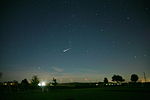Satellite flare
|
|||
|
|||
Satellite flare, also known as satellite glint, is the phenomenon caused by the reflective surfaces on satellites (such as antennas, SAR or solar panels) reflecting sunlight directly onto the Earth below and appearing as a brief, bright "flare".
The Iridium constellation with 66 active telecommunication satellites in low Earth orbit are known to cause the brightest flares of all orbiting satellites.
Time and place of the satellite's flare can be predicted only when the satellite is controlled, and its orientation in space is known. In this case it is possible to predict the exact time of the flare, its place in the sky, the brightness and duration.
Most Iridium satellites are still controlled, so their flares can be predicted. The Iridium communication satellites have a peculiar shape with three polished door-sized antennas, 120° apart and at 40° angles with the main bus. The forward antenna faces the direction the satellite is travelling. Occasionally, an antenna reflects sunlight directly down at Earth, creating a predictable and quickly moving illuminated spot on the surface below of about 10 km (6.2 mi) diameter. To an observer this looks like a bright flash, or flare in the sky, with a duration of a few seconds.
Ranging up to −8 magnitude (rarely to a brilliant −9.5), some of the flares are so bright that they can be seen in the daytime; but they are most impressive at night. This flashing has caused some annoyance to astronomers, as the flares occasionally disturb observations.
As the Iridium constellation consists of 66 working satellites, Iridium flares are visible quite often (2–4 times per night). Flares of brightness −5 magnitude occur 3–4 times per week; −8 magnitude may be visible 3–5 times per month for stationary observers.
Flares may also occur from solar panels, but they are not as bright (up to −3.5 magnitude). Such flares last about twice as long as those from the main mission antennas (MMA), because the so-called "mirror angle" for the solar panels is twice that for the MMAs. There are also rare cases of flares from MMAs and solar panels, or two MMAs (front and either right or left) of one satellite in a single pass.
...
Wikipedia



